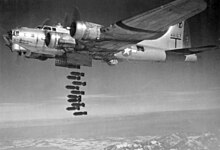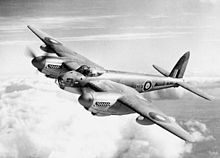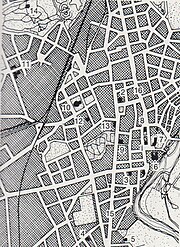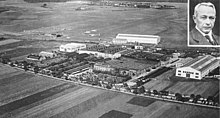Air raids on Dessau
The city of Dessau in Anhalt in central Germany experienced a total of 20 attacks from August 1940 to April 8, 1945 during the aerial warfare of World War II .
In addition to the three day raids by the United States Army Air Forces (USAAF) on May 28 and 30, 1944 and January 16, 1945, the night area attack by the British RAF Bomber Command on March 7, 1945, carried out in accordance with the Area Bombing Directive , particularly hit the city devastatingly. It was the greatest catastrophe that Dessau has experienced in its history. A total of 1,182 tons of bombs were dropped on Dessau by the USAAF and 1,862 tons by the RAF ; a total of 3,044 tons of bombs of all calibres up to heavy air mines . The city with its residential, cultural and industrial buildings was destroyed to over 80%, the inner city almost completely. Over 21,000 apartments were totally destroyed or badly damaged, over 11,000 moderately damaged. At least 1,136 people lost their lives and thousands were wounded.
After the incorporation of Roßlau (Elbe) on April 1, 1935, Dessau, "Gau capital" of the NSDAP-Gau Magdeburg-Anhalt , had a population of 123,000 in 1944 . The city was the location of several war-important factories, such as the Junkers Flugzeug- und Motorenwerke (JFM, 2 plants) and the Berlin-Anhaltische Maschinenbau AG ( BAMAG , 4 plants), in addition there were other large companies such as the Dessauer Waggonfabrik (branch of the Berliner Maschinenbau and Bahnbedarf AG , MBA), Junkers & Co. and the sugar refinery .
Air defense, air defense
In addition to the usual expansion of air raid shelters for the population, extensive factory air raid shelters have been built since May 1938.
The bunker construction program running from September / October 1940 after the British air raids on Berlin in the German Reich initially provided for 8, then 12 air raid shelters : 11 raised bunkers and one deep bunker. 8 bunkers were completed in August 1943, for 15,000 Dessau residents. In 1944, 46,000 people found protection in air raid shelters in residential buildings and public buildings: “total protection” 90%. The bunkers were built in busy places in the city, in areas without a basement, for hospitals and rescue centers, near industrial plants. A large shelter structure - disguised as a residential building - in Heidestrasse comprised an underground bunker, sleeping bunker and a rescue station. The provision of shelters will have contributed to the fact that the number of fatalities in Dessau - compared to the degree of destruction of the city - remained manageable even in the firestorm on March 7, 1945.
Dessau was part of the "Luftgau IV". In 1944, 13 heavy flak batteries with 81 tubes, 4 light flak batteries with 71 tubes, 5 headlight batteries and one fog battery were stationed in the region. Some of these flak batteries were withdrawn for use at the front.
Since December 1943 women, children and the elderly have been evacuated; by September 1944, 20,000 people from Dessau had left the city.
The individual air strikes
This representation is largely based on the book by Frank Kreißler (City Archivist of Dessau), published in 2004, “Dessau in Trümmern. Pictures from Dessau 1940 to 1945 ”to partly also to Olaf Groehler (aerial warfare historian): Anhalt in aerial warfare .
Up until January 1944, the air raids on Dessau consisted of nightly bombing by stray British planes whose actual target was Berlin , or "emergency drops" of bombs. In addition, in the summer of 1940, large numbers of phosphorus-containing fire platelets were thrown over Anhalt by the RAF , with the aim of setting ripe cornfields on fire ( Operation "Razzle" ).
- 19./20. August 1940: The night raid by the RAF with some Whitley bombers hit the West City with 4 high explosive and 100 incendiary bombs . The Askanische Strait, east of the sugar refinery, was hit . Munich court destroyed. 6 dead.
- November 23, 1940: Night raid by the RAF on Weststadt with 4 high explosive and 30 incendiary bombs. No damages.
- 15./16. December 1940: Attack by the RAF with Hampden bombers at 4.40 a.m. on Weststadt with 9 high-explosive bombs, including 3 with long-term detonators . Destruction in Amalienstraße and at Friedhof 2 (today Polling Park). 6 dead, including 4 women.
- March 13, 1941: Attack by the RAF at 4.30 a.m. with 5 high-explosive and 50 (120) incendiary bombs on Dessau-Alten . No damages.
- April 10, 1941: Night raid by the RAF with 3 high explosive and 50 incendiary bombs on Dessau- Kleinkühnau : property damage.
- April 18, 1941: Night raid by the RAF with 6 high-explosive bombs on Dessau-Alten and railway facilities
- August 1941 15: Attack of the RAF in the early morning with 4 explosives, 60 fire and 15 flares at the train yard and residential buildings. A dead one.
- 15./16. June 1943: Night attack by RAF fighter-bombers Mosquitos with 4 high- explosive bombs on the Scheplake . A dead (child).
- 20./21. June 1943: Night raid by RAF mosquitos on the southern part of the city with 4 high-explosive bombs. 30 houses were slightly damaged.
- August 31/1. September 1943: Night raid by the RAF on the airfield with 14 high-explosive bombs , 270 stick incendiary bombs , 20 phosphorus canisters and one mine bomb. Most of the bombs fell on the extensive airport grounds, but 20 residential buildings were also damaged.
- 22./23. November 1943: Night raid by the RAF on Südstadt with some high-explosive and phosphorus incendiary bombs.
- January 21, 1944: Night raid by the RAF on the Südstadt with 3 high explosive bombs, 2 mine bombs and 27 phosphorus incendiary bombs

The American daytime attacks, which began on May 28, were carried out by strategic bombers of the USAAF's 8th Air Fleet , which had taken off from their bases in eastern England accompanied by numerous long-range fighters .
- May 28, 1944 : First heavy day raid by the United States Army Air Forces on Dessau as part of a strategic bombing of targets in central Germany. An air raid alarm in Dessau at 1:54 p.m. From an attack height of 6,000 to 7,000 meters and under strong defense by German flak and fighter planes, a total of 48 "Flying Fortresses" B-17 dropped their bomb load over Dessau under a cloudless sky : 274 500-pound high -explosive bombs, 20 300-pound explosives High explosive bombs, 607 100 pound high explosive bombs, and 20 incendiary bombs. Downtown Dessau was hit “with full force”. At 2:17 p.m. all public clocks stopped. 114 people died, 160 were wounded, 43 of them seriously. 1,146 residents were left homeless . 149 houses were totally destroyed or badly damaged, 149 moderately and 564 slightly damaged. The most severe damage occurred in the area between Zerbster Strasse and Schloßstrasse in the east, Askanischer Strasse in the south, Amalienstraße in the west and Leopoldstrasse (today Ferdinand-von-Schill-Strasse) in the north. Numerous public and cultural buildings were also destroyed or badly damaged: Palais Reina ( Anhaltische Gemäldegalerie ), the Messelhaus (city villa, "House of the Reich Governor"), Löwen pharmacy, Altmann pastry shop, Antoinetten Lyceum, Johanniskirche , Hauptwache am Schloßplatz, Orangery at the Lustgarten (scenery warehouse can no longer be saved), concert hall of the old theater , Deutsche Bank, several cinemas, homes and schools. The following were hit with moderate severity: Marienkirche , Neues Dessau Theater (on Kaiserplatz, today Friedensplatz), a grammar school. The Dessau sugar refinery was hit hardest by large companies, the Junkers aircraft and engine works , the Schade brewery, the port and warehouses were hit hardest . The infrastructure was severely disrupted. The official memorial service took place on May 30th at the Ehrenfriedhof on Heide-Straße, the coffins were covered with swastika flags.
- May 30, 1944 : American day attack again. Immediately after evaluating the aerial photos of May 28, the high command of the 8th US Air Force made the decision to launch a new attack, which was to apply in particular to the Junkers factories, which had largely failed two days ago. Shortly after 11.00 a.m. on May 30, under a cloudless sky, 83 strategic bombers with strong escorts dropped 190 tons of bombs in just 10 minutes: 578 500-pound explosive bombs and 293 100-pound liquid incendiary bombs. The carpet of bombs on both Junkers factories had "extraordinary impact". 42 people died (including 12 foreigners) and 266 were wounded. The neighboring settlement areas were also affected, this time the city center less: the New Dessau Theater and the Evangelical Club House (soldiers' home), which burned out. The funeral service took place on June 2nd in the city park in front of the "threatening backdrop of the heavily destroyed Old Theater".
Activity reports received from companies and departments after the two attacks on May 28 and 30 provide a vivid picture of the damage and the dedicated repair work by the fire police , tram company , electricity company , water company , Schade brewery, sugar refinery and German Continental Gas -Society .
- July 20, 1944 : American attack, from 11:37 a.m. 107 Flying Fortresses B-17 dropped 208 tons of explosive bombs, mine bombs and 45 tons of incendiary bombs over Dessau. Over 300 explosive bombs fell in the northern part of the Mosigkauer Heide . Serious damage occurred particularly in the Junkers factories (also Junkers high-rise) and the neighboring residential areas ( Dessau-Siedlung and Dessau-Alten), and the sugar refinery and BAMAG-Werk II were also hit. 13 people died and 134 were left homeless. The funeral service took place in front of the Dessau Theater.
- August 16, 1944 : Around 250 aircraft attacked the Junkers engine works and the adjacent residential area (Dessau-Siedlung and Dessau-Alten). The city center was not affected. A number of downed American and British planes went down nearby. Engine production was severely affected, but continued. 33 people lost their lives, 29 were injured. Factory employees were not among them. A funeral service took place in the Palais-Garten (city park) on August 18th.
- September 28, 1944 : Dessau was the "accidental target" of bombers who had started for Magdeburg , Merseburg - Leuna and Kassel . Residential areas in Dessau-Nord and the Wasserstadt were hit . This attack was particularly costly for the population: 70 dead, including 48 women and 11 children; 79 wounded.
- January 16, 1945 : Dessau was a "target of opportunity" for American bombers. From 2 p.m. they dropped their bomb load on the city in 20 minutes. The main areas were the western inner city and the station district, the area south of the inner city and the Gropius settlement (with its light concrete buildings and unsafe cellars). BAMAG Plant III and IV were also hit, including the bunker in which the plant fire brigade was waiting for action: 34 dead and numerous injured. A total of 184 people died in the attack.


- March 7, 1945 : Heavy night raid by the RAF on the target Dessau with the code name "Shad" ( Allis shad , the deputy of Arthur Harris , Commander-in-Chief of the RAF Bomber Command , was Air Vice-Marshal Robert Saundby . The enthusiastic angler provided all the candidates German cities with a "Fish code".)
According to the British Area Bombing Directive , the 1st, 3rd, 6th and 8th Bomber Group had the task of destroying the built-up area of Dessau, neighboring industry and the railway facilities. Official reason: interrupt supply lines and disorganize the escape of officials from Berlin. 520 heavy Lancaster bombers and 6 mosquitos left their bases in England at around 5 p.m. On the outbound flight they were attacked by German interceptors , 18 bombers did not return. The bomber armada had loaded 1,000-pound high-explosive bombs, 4,000-pound mine bombs and incendiary bombs, each containing 108 stick bombs. The ratio incendiary bombs to bombs of 55 to 45 was clear indication that a wildfire should be triggered. At 9.49 p.m. each of the 6 mosquitos flying ahead dropped a mine bomb on Dessau, at 9.53 p.m. the first bombs of the subsequent stream of bombers fell, and the main attack began at 10 p.m. The fixed landmark, the museum tower, was easy to see when the cloud cover was torn. By 10 p.m., 1,693 tons of bombs rained down on the city. The wildfires, which developed into a firestorm, could be seen 180 km away by the returning bomber crews. The city's degree of destruction was over 80%. Almost all important buildings in the city were totally or subtly destroyed. The chief of the regulatory police reported: “Badly hit: Junkers-Flugzeugwerke, Junkers-Motorenwerke, Apparatebau Junkers, BAMAG 1,2,3,4, chemical factory, Dessau wagon factory, sugar refinery, Mitsching brewery, damage to residential buildings cannot yet be overlooked. Still badly hit: Post office, Stadtsparkasse, Kreissparkasse, tax office, Luther school, elementary school, crematorium, deaconess house, police headquarters, police stations, hygiene institute, pension office, main customs office, welfare and youth welfare office, Wallwitzhafen. Severe failures in gas, water and electricity. Tram depot, Reichsbahn repair shop, central station badly hit, the latter burnt out. Radio, telex and telephone connections disrupted. ”Because of the“ infernal extent of the horror ”there could no longer be organized fire-fighting and rescue assistance, the residents were dependent on mutual and self-help. In the morning the order was given to evacuate all women and children, and makeshift homes were set up in the vicinity of the city. A huge cloud of smoke stood over the burning ruins of the city, through which daylight could barely penetrate. 668 fatalities were mourned, but this number is not complete because of the catastrophic circumstances. "It was one of the worst arson attacks of the war".

- 8/9 April 1945 : the 20th bombing raid on Dessau took place that night. The British plan of attack envisaged a massive double strike from mosquitos on Dessau. At 10:28 p.m. the first target marker bomb was dropped over Dessau, the first wave of six mosquitos had considerable navigation problems. The mine and high-explosive bombs fell far from the center of the city. At around 10:56 p.m., the second wave of 42 mosquitos reached the city. 17 mine bombs (4,000 HC) and 88 high-explosive bombs (500 MC) are dropped by 11.11 p.m. The aircraft crews observed violent detonations in the city. The chief of the regulatory police reported on April 9th: “25 residential and farm buildings total (destroyed), severe hospital, Junkers works, sugar factory and railway facilities hit. Number of fires in the city center. ”There are no sources of victims.
In April, low- flying aircraft were a permanent threat, they shot at railroad trains, carts and even individuals with their on-board weapons.
The attack by American ground troops on the ruined city of Dessau began on the morning of April 21, 1945, and the city was occupied on April 22.
Loss of cultural buildings
This compilation is based on the chapter Dessau by Renate Kroll in Fates of German Monuments in World War II . Edited by Götz Eckardt, Berlin 1978. pp. 305–323
Churches
- Castle and town church St. Marien : on March 7, 1945 except for the tower (which was then secured by an emergency roof) and the surrounding walls destroyed, also the interior and the Rühlmann organ. Reconstruction of the church only from 1989 to 1998.
- Johanniskirche (former Neustädter Church): destroyed with the exception of the surrounding walls in the air raid on May 28, 1944
- Georgenkirche : destroyed on March 7, 1945 except for the surrounding walls. Simplified reconstruction from 1961 to 1966.
- Pauluskirche : heavily damaged on March 7, 1945 and rebuilt in a simplified manner.
- Jakobuskirche : on March 7, 1945 burned down to the surrounding walls. Ruin blown up in 1977 during protests.
Ducal buildings
- Ducal castle : on March 7, 1945, the east and south wings destroyed (ruins removed). The Johannbau burned down to the surrounding walls, was only given an emergency roof in 1957, was only rebuilt from 1990 to 2005 with a different interior design (now the Museum of City History).
- Lustgarten: destroyed by air raid, ruins removed
- Pavilions in the Lustgarten: destroyed on March 7, 1945, ruins removed in 1966
- Reitbahn (later Friedrich-Theater): destroyed on March 7, 1945, ruins removed in 1966
- Mar stables: destroyed on March 7, 1945, ruins removed in 1966
- Orangery and Neue Hauptwache: on May 28, 1944, except for the remains of the facade, destroyed, ruins removed
- Guest house in the Georgengarten (Lustgarten): destroyed except for the surrounding walls, ruins preserved
- Kitchen building in Georgengarten: destroyed by air raid
- Turnpike house on the promenade wall: destroyed by air raid on September 28, 1944, ruins removed
Public buildings
- Dessau town hall : upper floor burned out on March 7, 1945, facade on the north side badly damaged. Reconstruction.
- Dessau main station : on March 7, 1945 the station building was destroyed. New building.
- Old theater : destroyed on May 28, 1944, burned out. Partial rebuilding.
- Landestheater (Kaiserstraße, then Friedensplatz) (1935–1938): Stage house and interior rooms destroyed on May 30, 1944, burned out.
- Bauhaus Dessau : badly damaged in air raids, the upper floor of the technical school wing and the glass facade on the workshop wing destroyed. House of the Bauhaus director destroyed by air raid, master houses damaged.
Squares and streets (important buildings)
- Palace Square (before 1934 Großer Markt): all buildings destroyed on March 7, 1945, ruins removed except for the west wing of the palace
- Dessau booths : destroyed on March 7, 1945, ruins removed
- Schlossplatz 1 (New Chancellery, Hofkammer): destroyed on March 7, 1945, ruins removed
- Neumarkt 1–2: destroyed on May 28, 1944, ruins removed
- Franzstrasse 15: destroyed on March 7th, ruins removed, western gatehouse preserved
- Franzstraße 19 (Neues Gleisstift): destroyed by air raid, ruins removed
- Franzstraße 20 (former poor and work house): destroyed by air raid, ruin torn down
- Kaiserstraße 24-25 (Palais Eduard, Anhaltische Landesbücherei): destroyed by air raid, ruins removed
- Kavalierstrasse 5–6 (Palais des Prinzen Georg, Anhaltische Gemäldegalerie): on May 28, 1944, destroyed except for the facade, demolished
- Kavalierstrasse 33 (Palais Oppenheim, temporarily the seat of the State Museum): on May 28, 1944 destroyed except for the facade and part of the vestibule, ruins removed
- Kreuzgasse 9 (half-timbered building from 1580): destroyed on March 7, 1945, ruins removed
- Kreuzgasse 10a (half-timbered building from 1673, seat of the Anhaltischer Kunstverein): destroyed on March 7, 1945, ruins removed
- Muldstrasse 24 (pleasure gardener's apartment, stable master building): destroyed by air raid, ruins removed
- Poststrasse 11–12 (1792/93): burned out on March 7, 1945, ruins removed
- Schlossstrasse 1,2,3,8,9,19: burned out / destroyed on March 7, 1945, ruins removed
- Steinstrasse 1,65,66,67,68: destroyed on March 7, 1945, demolished
- Wallstrasse 10 and 15: destroyed by air raid except for the surrounding walls, ruins removed
- Zerbster Straße 22 (Haus Oranien): Destroyed March 7, 1945, ruins removed
- Zerbster Straße 24 (on the former Kleiner Markt: Gasthof Schwarze Bär): destroyed by air raid, ruins removed
- Zerbster Strasse 28 (Goldener Löwe): Destroyed March 7, 1945, ruins removed
- Zerbster Straße 29: destroyed on March 7, 1945, rebuilt until 1952
- Zerbster Strasse 34: destroyed on March 7, 1945, ruins removed
- Zerbster Straße 38–39 (rectory of St. Mary's Church): destroyed on March 7, 1945, ruins removed
- Zerbster Strasse 40: destroyed on March 7, 1945, ruins removed
- Zerbster Straße 41 and 42 (on the west side of Schlossplatz): destroyed on March 7, 1945, ruins torn down
- Zerbster Strasse 52: burned out on March 7, 1945, rebuilt 1961–1962 as a city library
- Zerbster Strasse 60: destroyed on March 7, 1945, ruins removed, courtyard building preserved
- Zerbster Strasse 65: destroyed on March 7, 1945, ruins removed
- Zerbster Straße 69 (Palais Branconi, Kristallpalast restaurant): on March 7, 1945 burned out to the surrounding walls
Human losses
At least 1,136 people lost their lives as a result of the air strikes; 618 were women, 165 children, 113 foreigners and 13 members of the Wehrmacht . The real death toll "could be higher, since on March 7, 1945 only the deaths recorded by the registry office could be taken into account".
Burial and memorial sites in Dessau
- On December 10, 1950, a memorial was erected in front of the ruins of the Johanniskirche , on which the names of all registered bomb victims were recorded. It only survived until the St. John's Church was rebuilt in 1955.
- In 1985, at the memorial cemetery in the cemetery area 2 a stele commemorating the bombing inaugurated on 7 March 1945 with the inscription: "Memento 7 March 1945". The stele stands on a very large area with the grave fields of the Dessau bomb victims. Every single registered dead person has a stone with his name on it (without date of birth or death). Some of the surfaces are weathered and mossy and can hardly be deciphered.
- Since June 3, 1994, a memorial stone in the cemetery of honor has been warning : "The dead of World War II: 1939. 1940. 1941. 1942. 1943. 1944. 1945". In the cemetery of honor there are graves and memorial stones for those who died in World War I and II. Sometimes the names and dates on the grave crosses have been made unrecognizable by chiselling, and removed grave stones from World War I have been replaced by simple, small ones. In the cemetery of honor there is a large memorial from the 1920s for the Dessau people who died in World War I, with their names.
Cemetery of honor
Stele in cemetery 2 in memory of the night RAF bombing raid on March 7, 1945
literature
- Roger A. Freeman: Mighty Eighth War Diary . JANE's. London, New York, Sydney 1981. ISBN 0 7106 00 38 0 .
- Olaf Groehler : Mission No. 1027 - the air raid on Dessau on March 7, 1945, based on British archive documents . Contributions to the history of the city. Ed. Museum for City History. Dessau 1986
- Olaf Groehler: bombing war against Germany . Akademie-Verlag, Berlin 1990. ISBN 3-05-000612-9 .
- Olaf Groehler: Anhalt in the air war, 1940-1945. Approach to IDA-EMIL . Ed .: Technology Museum "Hugo Junkers" Dessau, Förderverein eV, Anhaltische Verlagsgesellschaft mbH Dessau, 1993. ISBN 978-3-910192-05-8 .
- Frank Kreißler: Dessau in ruins. Pictures from Dessau 1940 to 1947 . Funk-Verlag Bernhard Hein eK, Dessau 2004. ISBN 3-936124-64-7 .
- Renate Kroll: Dessau (Dessau district) . In: Fate of German Monuments in World War II . Edited by Götz Eckardt. Henschel-Verlag, Berlin 1978. Volume 2. pp. 305–323.
Web links
- Jan Friedmann: Dessau: sinking in a firestorm
Individual evidence
- ^ Olaf Groehler: Bomb war against Germany . 1990. p. 449
- ^ Renate Kroll: Dessau in Fate of German Monuments in World War II . Edited by Götz Eckardt, Berlin, 1978. p. 305
- ^ Frank Kreißler: Dessau in ruins . 2004. p. 9
- ^ Frank Kreißler: Dessau in ruins. Pictures from Dessau 1940 to 1947 . Dessau 2004. pp. 10-13
- ^ Olaf Groehler: Anhalt in the air war . Anhaltische Verlagsanstalt, Dessau 1993. pp. 7 and 8
- ^ Frank Kreißler: Dessau in ruins. Pictures from Dessau 1940 to 1947 . 2004. p. 54 ff
- ↑ Fish code names , (British original, PDF; 292 kB), German translation (PDF; 214 kB), on: bunkermuseum.de ( Bunkermuseum Emden ), accessed on October 2, 2017
- ^ Olaf Groehler: Anhalt in the air war . Dessau 1993. p. 146
- ^ Olaf Groehler: Bomb war against Germany . 1990. p. 422
- ^ Olaf Groehler: Anhalt in the air war . Dessau 1993. pp. 162-163
- ^ Frank Kreißler: Dessau in ruins. Pictures from Dessau 1940 to 1947 . 2004













